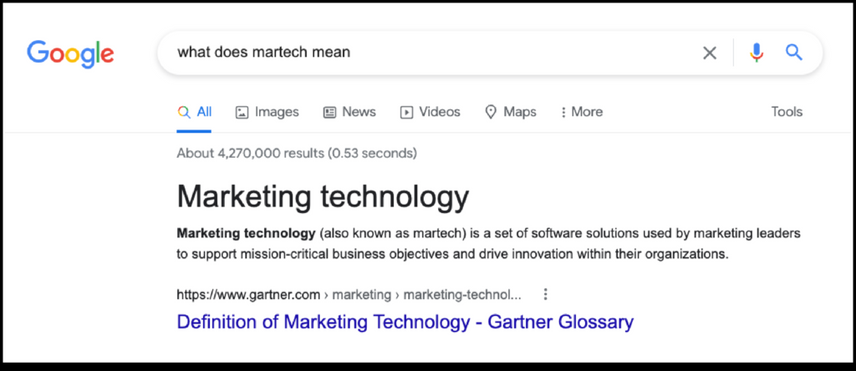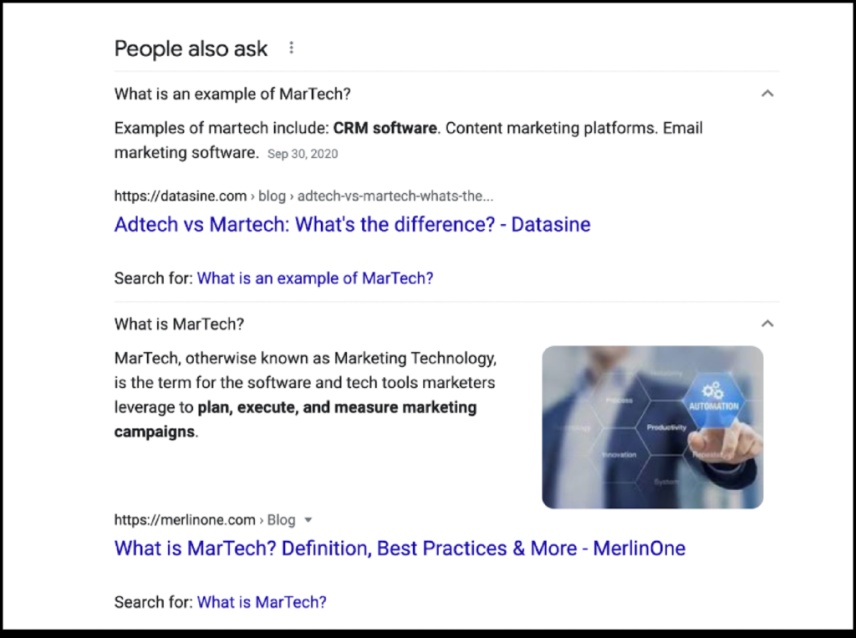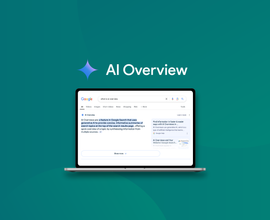Level Up Your Approach: 7 Winning Enterprise SEO Strategies for B2B Brands
Implementing the right enterprise SEO strategies for B2B brands can help your content earn the top rankings on SERPs and increase organic traffic to your site.
The amount of data created online every day is astounding. According to International Data Corporation (IDC), 64.2 zettabytes (ZB) of data were created in 2020. Not familiar with a zettabyte? It's equal to one billion terabytes, and you can express it as a one with 21 zeros after it. What does this mean to you as a B2B marketer? This overwhelming amount of data underscores why a "build it, and they will come" philosophy won't work to generate web traffic in today's oversaturated online marketplace. You're competing for attention in an information-overload world, and you have to consider that in your enterprise strategy formulation and digital marketing planning. That's why you need a focused approach to implement enterprise search engineSearch Engine
A search engine is a website through which users can search internet content.
Learn more optimization (SEO) strategies that get results.
Enterprise SEO aims to improve organic search visibility for large businesses, often in the Fortune 1000, by focusing on both high-level and more granular SEO approaches. With robust enterprise SEO strategies, you can run awareness-building campaigns and highly-targeted regional or product-specific campaigns to increase your brand’s visibility on SERPs (search engine results pages).
The goal of every campaign is to get the right content in front of the right target audiences and drive more organic traffic to your website. Enterprise SEO is key to expanding your brand’s digital presence.
Why your B2B enterprise needs to care about SEO
Some B2B companies believe SEO is primarily a business-to-consumer (B2C) tactic. But nothing could be further from the truth. SEO should be the building block of your enterprise marketing strategy for both B2B and B2C in today’s digital-first world.
However, it's important to delineate that B2C and B2B SEO have different aims. B2C SEO marketing strategy is all about drawing high volumes of potential customers to a site and driving immediate transactions. By contrast, B2B SEO is about attracting more targeted leads, delivering quality content that provides value to the target audience, and guides prospects through a longer, more complex sales funnel.
Even if your company is a household name or a leader in your niche industry, SEO is still essential for continued growth. An effective, comprehensive enterprise SEO strategy can support your marketing efforts at every step of the sales cycle, from initial awareness to closing the deal.
Here's why:
- Most B2B buying journeys start online. As reported in Forbes , many B2B purchasers are looking for ways to make their jobs easier. Kicking off the buying process with online research has become the norm. Ranking at the top of the SERP for key search queries can put you on the radar of these buyers and draw them to relevant pages on your site based on their search intent.
- Buyers want you to meet their needs at each stage of the buying journey. Vendors have traditionally tailored content to the awareness and purchase stages. But a Forrester survey found that 90% of respondents wanted relevant content at each step of the buying journey. SEO can help stakeholders find stage-specific content to help keep deals moving forward.
- More B2B buyers are transacting online. Historically, B2B sales have been relationship-driven, but today's buyers are more comfortable buying digitally. According to McKinsey & Company research, 77% of B2B buyers are willing to spend $50,000 on a given solution, with 35% comfortable spending more than $500,000 on the right technology. SEO helps ensure you're top-of-mind with purchase-ready prospects.
Winning enterprise SEO strategies for B2B
Enterprise SEO can drive a significant influx of organic traffic, but it takes more than optimizing your site for a few keywords. Implementing these seven B2B SEO strategies can lead you toward lasting success and reliable growth.
1. Map keywords to every stage of the buyer's journey
It's easy to assume that the keywords you target should focus primarily on attracting prospects to your site the first time. Once they're on your site, you can engage them with in-depth content and stay in touch through outbound campaigns. That's true, but it's also shortsighted.
In today's environment, you need to fine-tune your keywords to map to every stage of the buyer's journey. You need to know what questions people ask when they're building short lists in the consideration stage and nearing a purchase decision.
The reason? The old-school notion of the linear sales funnel is no longer relevant in today's digital world. You can't assume that you've captured a prospect's attention after they've visited your website, signed up for your mailing list, or talked to your sales team.
The B2B buying journey is no longer linear . Instead, buyers now execute a series of specific tasks, but not chronologically, and may often revisit steps. This is especially true if multiple stakeholders have a say in the final decision.
How do you navigate the new nonlinear B2B buying process? You have likely already taken some steps by creating tiered content aligned with different phases of the buying journey. It's essential to use the same approach for your keywords:
A lot of [speakers at C3] have mentioned tiered content—I recommend doing the same with keywords. Being able to map keywords to different stages of the buyer’s journey is huge.
2. Go after featured snippets and people also ask search results
One sure-fire way to achieve top organic rankingsRankings
Rankings in SEO refers to a website’s position in the search engine results page.
Learn more is to appear as a "featured snippet" or in "people also ask" search results. These two unique result types appear on Page 1 of Google, establish authority for your brand, and can influence search behaviors.
Here's what they are, in a nutshell, along with examples:
- Featured snippet. Excerpts from a site that provide a short answer to a query and may include a short paragraph, list, video, or other highlighted content. See the example below.

- People also ask. A Google feature that gives people information related to their query that they may find useful. Each question ties to a featured snippet, along with additional questions and answers. See the example below.

As Search Engine Land explains, you can specifically angle your content to target these two high-value page placements. Landing these high-value positions is extremely competitive, but the Conductor platform can give you an edge. With Conductor's Result Type report, you can gain in-depth insights on who is ranking for these search types and how that content earned the top spot, along with targeted improvements you can pursue to try to win that result type.
Additionally, with Conductor, you can identify search queries that you already rank for. You can use this data to your advantage by updating those high-performing pages with a short, targeted answer of approximately 40 to 50 words that addresses the specific query for your best chance at winning a featured snippet or people also ask result. Alternatively, you can address the query using a list or table if those formats are a better fit for your response. It may take time and persistence to achieve the results you are looking for, but scoring a coveted "position zero" on a SERP for a keywordKeyword
A keyword is what users write into a search engine when they want to find something specific.
Learn more with high MSV provides some of the highest returns on investment in the form of increased traffic and conversions.
3. Target striking distance keywords
In SEO, a keyword that achieves a rank on page two or three of search results is known as a striking distance keyword. While you aren't quite where you want to be on Page 1, achieving that goal is within "striking distance," where implementing the right optimizations to a given page or creating a net new SEO-focused landing page can help bump you to Page 1.
Targeting the highest-potential striking distance keywords can help you elevate your search presence relatively quickly—in weeks, not months—but only if you use the right platform. Relying on bare-bones SEO tools can get you there, but require significant manual analysis and data crunching.
Conductor's full-featured enterprise SEO platform gives you in-depth insights on the striking distance keywords at your fingertips. Our platform's advanced functionality provides robust, automatic segmentation to spotlight high-potential keywords to target when enhancing your content. Even moderate gains in position can yield significant increases in traffic.
Just how much traffic can you gain? Our analysis found a five-position increase from 21 to 16 led to a 50% increase in traffic. However, five-position movement from 11 to 6 achieved over 5x those results—an impressive 273% traffic growth.
4. Optimize landing pages for search and customers
When marketing to B2B brands, landing pages are an effective way to secure prospect contact details. But they have to be optimized to target both users and search engines to maximize results.
How? First, you need to think about the perspective of your visitors. What are they searching for? Analyzing your existing keyword and organic search performance can help you understand what types of language your target audience is using and incorporate that into your content.
Look at how the user is actually searching, and make tweaks, like creating landing pages, to fit this.
You'll also need to follow proven on-page SEO techniques by including elements like title tags, meta descriptions, and images or videos. These features, along with your URL, let search engines and users know what value your page delivers to target audiences.
An intelligent landing page strategy can deliver big gains for your business, and you can build on the success of one page to create more. Recent data shows companies with more than 30 landing pages achieve 7x the results of those with fewer than ten landing pages.
5. Adopt a hub and spoke content marketing strategy
When exploring content ideas for your site, you may come up with several topics you need to address in-depth to cover them fully. Instead of trying to cram all the details into a single long-form content offering, you can create several pieces that relate and link to one another.
This is the essence of the hub and spoke B2B content marketing strategy. You define one central topic as your hub and create connected pieces—or spokes—to build on it. Typically, the hub will feature content with higher volume keywords, while spokes highlight content with lower volume, long-tail, and supporting keywords.
You'll start with keyword research first to uncover what topics are top-of-mind with prospective site visitors. Through this research—supplemented with competitive analysis—you can prioritize content to development.
How does a hub and spoke approach deliver value? It presents you as an authority on a specific subject while helping you rank for more keywords related to that topic. As you rank for more keywords and present yourself as a knowledge leader, you can draw more organic traffic, which can add up to more sales over time.
According to a report in Search Engine Journal , one company achieved position one rankings for every keyword on its hub page—a clear traffic-generating win.
6. Optimize internal linking
An internal link connects one page of your site to another. While links can help visitors find other content of interest and spend more time on your site, they also serve an essential SEO purpose. Through internal linksInternal links
Hyperlinks that link to subpages within a domain are described as "internal links". With internal links the linking power of the homepage can be better distributed across directories. Also, search engines and users can find content more easily.
Learn more, you help search engines better understand your site's structure.
Search engines can't find pages on your site if there are no links to them. What's more, search engines like Google view pages with more reputable links as having a higher value—which counts for internal and external links. You can't always control which pages point to your site, but you have full ownership of internal linking.
Keep in mind that too many links can be overwhelming for users. You should optimize internal linking by selectively linking to pages that will most likely interest visitors and provide the most value. That way, you can help search engines crawl your site while delivering value to visitors and enhancing the user experienceUser Experience
User experience (or UX for short) is a term used to describe the experience a user has with a product.
Learn more.
This is why a clear internal linking strategy is a key element of any B2B SEO strategy. Get started by defining your most important content pieces, known as cornerstone content, and then identify pages that should link out to them on your site. You should also use a hierarchical format with links between parent and child pages. These two foundational tactics can improve your site's internal linking and drive more prominent search placements.
7. Implement regular content maintenance
You can't use a "set it and forget it" approach with SEO. Instead, you need to perform specific tasks regularly to keep your content and on-page SEO elements up-to-date.
For best results, you should identify the top-performing pages on your site that generate the most traffic. For example, you may publish a report highlighting annual statistics or trends that attract interest and becomes a top-performing piece of content for you. Still, it will need to be updated each year to continue to deliver value and drive traffic. You should also refresh seasonal pages—like event promotions or content focused around a given holiday—that draw traffic at specific times. Create a plan to update these pages quarterly or annually based on bandwidth, content needs, and search interest.
Use Conductor's SEO platform to closely monitor search performance and know which pages need attention with real-time alerts. Drops in search engine rankings, click-through rates, time on page, pages visited, or other key metrics are all clues that content maintenance is needed ASAP.
Also, look for broken links that can frustrate visitors and prevent search crawlersCrawlers
A crawler is a program used by search engines to collect data from the internet.
Learn more from understanding your site structure. Have a process in place, so you regularly replace 404s with authoritative, relevant links as soon as you become aware of the issue. Take opportunities to refresh content to stay current with the latest trends and data. Double-check that your keywords are still relevant and drawing traffic. If not, adjust and ensure your content, and on-page SEO elements reflect your new keyword targets.
Getting B2B SEO right
Today, SEO needs to be the foundation of your digital B2B marketing strategy, not an afterthought. With all the digital competitionCompetition
Businesses generally know who their competitors are on the open market. But are they the same companies you need to fight to get the best placement for your website? Not necessarily!
Learn more vying for your prospects' attention, you can't leave your organic rankings to chance and hope your prospects find you. Instead, you need a robust and multi-faceted SEO strategy to achieve quick wins and long-term traction.
These seven proven best practices can jumpstart your enterprise SEO strategy. You can also look to B2B trailblazers that are leading the way. One standout is HubSpot , a marketing, sales, and customer service solution provider. HubSpot has focused intensively on SEO as part of its enterprise software sales strategy—and it's paid off. The enterprise has achieved number one rankings for highly competitive search terms, such as "branding and "market research," along with driving more than 16 million monthly organic visits.
When launching or refining your enterprise's digital marketing strategy, look to leaders in your industry to see what types of content they are producing and which SEO strategies are helping that content rank well. Conductor's annual C3 conference—focused on all things SEO and organic marketing—brings together the brightest minds and cutting-edge SEO and digital marketing innovations today. Check out the C3 2022 hub for access to on-demand videos of every session from leaders and renowned B2B companies like IBM, Ernst & Young, SAP, and more.

![Nina Carlson, Online Marketing & Analytics Manager, [object Object]](https://cdn.sanity.io/images/tkl0o0xu/production/0b9580c4f91f98637f0ff2542b12f9f11b0074c5-600x600.png?fit=min&w=100&h=100&dpr=1&q=95)






